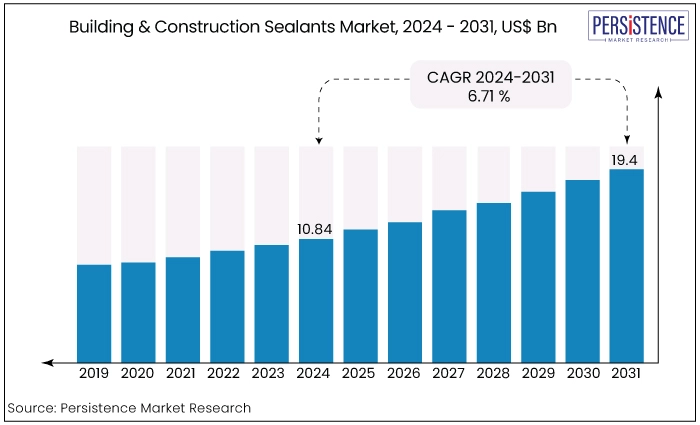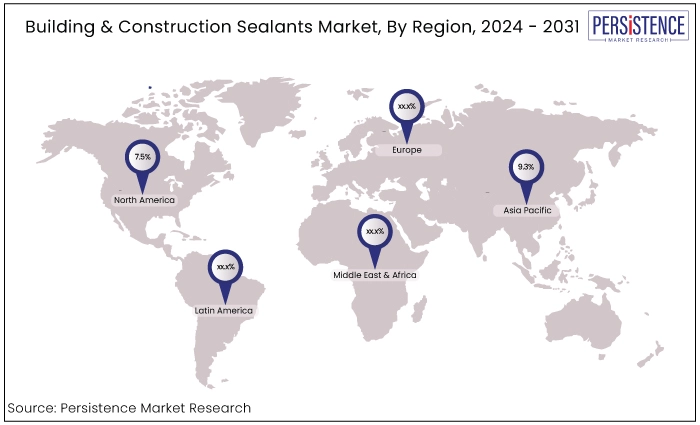Building & Construction Sealants Market
Industry: Chemicals and Materials
Published Date: August-2024
Format: PPT*, PDF, EXCEL
Delivery Timelines: Contact Sales
Number of Pages: 153
Report ID: PMRREP34736
The global building & construction sealants market is estimated to value at US$19.4 Bn by the end of 2031 from US$10.84 Bn recorded in 2024. The market is expected to secure a CAGR of 6.71 % during the forecast period from 2024 to 2031.
Key Highlights of the Market
|
Market Attributes |
Key Insights |
|
Building & Construction Sealants Market Size (2024E) |
US$10.84 Bn |
|
Projected Market Value (2031F) |
US$19.4 Bn |
|
Global Market Growth Rate (CAGR 2024 to 2031) |
6.71 % |
|
Historical Market Growth Rate (CAGR 2019 to 2023) |
6.23 % |

|
Region |
CAGR through 2031 |
|
Asia-Pacific |
9.3% |
Building and construction sealants were primarily sold in the Asia Pacific region in 2024. Growth in GDP, industrialization, and manufacturing production will drive the notably growing adhesives sector in Asia Pacific.
The growth of the business is expected to be significantly aided by China, Japan, and India. Healthcare, leather and footwear, DIY, furniture and woodworking, and the client market are the main markets.
India and China are expected to continue to see increased construction activity, which is driving the need for adhesives. To meet the demand for personalization, the adhesives industry has expanded faster because to technological advancements in Korea and Japan.
|
Region |
CAGR through 2031 |
|
Europe |
7.5% |
The building and construction sealants market is expected to expand at significant rate in Europe due to infrastructure development, and rehabilitation initiatives. For applications such as flooring, glazing, roofing, and sanitary, sealants are necessary to close gaps, joints, and seams. Europe market is estimated to record a CAGR of 7.5% through 2031.
The strict environmental sustainability and energy efficiency regulations of the European Union mandate the use of sealants in buildings in order to reduce energy consumption and provide insulation.

|
Category |
Projected CAGR through 2031 |
|
Resin - Silicone |
7.1% |
Silicone category is estimated to lead the building and construction sealants market with a significant CAGR of 7.1% in the market through 2031. Silicone sealant is an adhesive that is made of silicone polymers and is used to make durable, flexible sealants. It has exceptional adhesion, flexibility, resistance to water and weather, thermal stability, and adaptability.
Sealing seams in doors, windows, and facades is a common practice in the building and construction industry. As a result, reducing water infiltration, enhancing structural integrity, and raising energy effectiveness.
It is anticipated that over the projection period, the polyurethane category will expand at the fastest rate. With its many qualities, including flexibility, a broad range of hardness, rip resistance, and grease, resistance to mold, polyurethane is a material that is very adaptable. With a shorter lead time and less expensive tooling than typical thermoplastic materials, it is appropriate for use in roller, wheel, and insert applications.
|
Category |
Projected CAGR through 2031 |
|
Application - Flooring |
12.6% |
Flooring category is estimated to lead the building & construction sealants market through 2031with a notable CAGR of 12.6%. Due to their many advantages, roof sealants are becoming more and more popular. In addition to prolonging the roof's lifespan by reducing damage from harsh weather, they offer less expensive options to complete roof replacement.
By sealing the gaps and fissures surrounding chimneys and vent flashing, sealants can reduce energy use. Being a more environmentally friendly option, they also offer zero-wasting protection because they don't need to remove existing materials before application.
Roof sealants are a smart investment for homeowners seeking to improve the comfort and safety of their homes since they offer a number of benefits.
The building and construction sealants market is driven by the increasing use of materials in construction and evolving novel technologies. This market encompasses the global industry involved in the production, distribution, and application of sealants used in various construction activities.
Sealants play a crucial role in the building and construction sectors by linking and attaching various sections and elements to the main structure and to each other. They enhance performance by effectively keeping out humidity, moisture, and UV rays, which are vital for ensuring structural integrity and longevity.
As the construction industry continues to grow, the demand for advanced sealant technologies has risen significantly. Manufacturers are focusing on developing eco-friendly formulations that reduce VOC emissions and improve energy efficiency in buildings.
Innovations in multi-functional sealants now offer superior adhesion and flexibility while also contributing to overall building performance. These advancements are essential in meeting stringent regulatory standards and addressing the evolving needs of modern construction practices, further propelling the market's expansion.
Advances in technology are leading to sealants that offer superior adhesion, flexibility, and additional benefits like thermal insulation and fire resistance, catering to the demands of sustainable and high-performance building practices.
The building and construction sealants market has experienced substantial growth over the past few decades, driven by increased construction activities and the development of advanced materials. Innovations in sealant formulations have enhanced performance, providing superior adhesion, flexibility, and resistance to environmental factors.
The industry's focus on sustainability has also led to the creation of eco-friendly products, aligning with global environmental regulations. The market is poised for continued expansion as urbanization and infrastructure development surge worldwide.
The adoption of green building practices and smart technologies will further drive demand for high-performance, multi-functional sealants. Ongoing research and development efforts are expected to yield innovative solutions, meeting evolving industry requirements and contributing to sustainable construction practices.
Focus on Energy Efficiency in the Building and Construction Sealants Industry
The focus on energy efficiency in the building and construction sealants market has significantly affected several industries, including the sealants market. Sealants make buildings more energy-efficient by stopping the entry of air and moisture, which can lead to structural damage and energy loss, by caulking cracks and crevices.
An increasing number of builders and contractors are searching for high-performance sealants with superior air and moisture sealing qualities. These sealants help buildings become more energy-efficient overall, which reduces energy use and utility costs by reducing heating and cooling loads. Technological developments in sealants are driving the development of complex mixtures that result in higher energy efficiency gains.
Urbanization and Infrastructure Projects Drive Demand for Sealants
Urbanization and infrastructure projects are significant growth drivers for building and construction sealants companies, as increasing urban populations lead to a higher demand for residential, commercial, and public infrastructure. This rapid development creates a multitude of applications for sealants, from joint sealing in buildings to weatherproofing and moisture control in infrastructure projects.
As cities expand and aging infrastructure requires upgrades, the need for reliable sealants to ensure structural integrity and longevity becomes essential. Companies that can provide high-performance sealants tailored to these diverse applications will benefit from the growing construction activities associated with urbanization and infrastructure development.
Booming Construction Industry Remains a Key Driver
The construction industry is a key factor in the requirement for building and construction sealants. Sealants are essential building materials that are used for several purposes, such as stopping the entry of air and water and extending the life and durability of structures by caulking joints, gaps, and fractures. The construction of new buildings, residential complexes, and infrastructure is what drives the need for sealants.
As construction progresses, sealing materials becomes more and more necessary to preserve the energy efficiency and structural integrity of buildings. Current constructions require routine maintenance and repairs to withstand aging, weathering, and wear and tear. Sealants are widely employed in maintenance and repair operations to seal joints, halt further damage, and stop leaks.
Volatility in Raw Material Prices
The production of sealants relies heavily on petrochemical-based raw materials, such as silicone, polyurethane, and acrylics. These materials are subject to price fluctuations due to variations in crude oil prices, supply chain disruptions, and geopolitical tensions.
Volatility can significantly impact the cost structure of sealant manufacturers, leading to increased production costs. As a result, companies may face pressure to either absorb these costs, reducing profit margins, or pass them on to consumers, potentially leading to reduced demand.
Energy Efficiency Solutions to be a Prominent Opportunity
Energy efficiency solutions present a significant opportunity for building and construction sealants companies by developing products that enhance overall building performance. Sealants that improve thermal insulation and reduce air leakage can significantly contribute to energy savings in both residential and commercial buildings.
By integrating advanced materials and innovative formulations, companies can create sealants that not only provide superior adhesion and durability but also enhance energy efficiency. This focus aligns with growing regulations and consumer demand for sustainable construction practices.
Collaborating with architects and builders to promote energy-efficient solutions can further strengthen market presence and drive sales. Ultimately, investing in energy efficiency will position sealant manufacturers as leaders in the evolving construction landscape, addressing both environmental concerns and economic needs.
The competitive landscape of the building and construction sealants market is marked by the presence of the leading global players such as 3M, Henkel, Sika, BASF, and Dow Inc. These companies focus on continuous innovation, extensive research and development, and strategic mergers and acquisitions to strengthen their market positions.
Regional players and niche manufacturers contribute to a highly competitive environment. The market competition is driven by product differentiation, quality, and the ability to meet evolving regulatory standards and customer demands for eco-friendly, high-performance sealants.
Recent Developments in the Building & Construction Sealants Market
|
Attributes |
Details |
|
Forecast Period |
2024 to 2031 |
|
Historical Data Available for |
2019 to 2023 |
|
Market Analysis |
US$ Billion for Value |
|
Key Regions Covered |
|
|
Key Market Segments Covered |
|
|
Key Companies Profiled in the Report |
|
|
Report Coverage |
|
|
Customization & Pricing |
Available upon request |
By Resin
By Technology
By Application
By Region
To know more about delivery timeline for this report Contact Sales

The building & construction sealants market is estimated to value at US$19.4 Bn by the end of 2031.
The demand for building and construction sealants is fueled by increased construction activities, and emphasis on sustainable building practices.
Some of the key players operating in the market are 3M, Henkel AG & Co. KGaA, Sika AG, BASF SE, and Dow Inc.
Flooring segment to record the significant growth rate.
A compelling opportunity lies in developing eco-friendly formulations that meet growing sustainability demands.
Asia pacific to exhibit notable CAGR in the market.